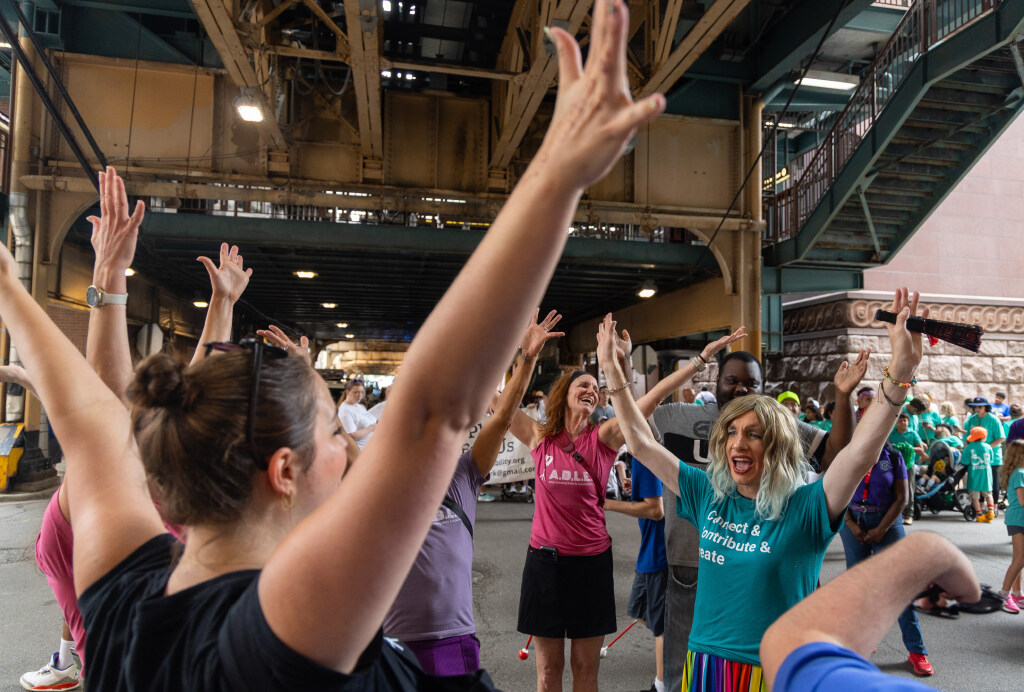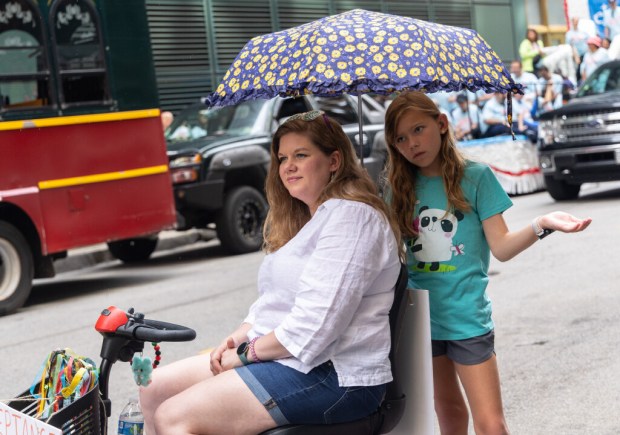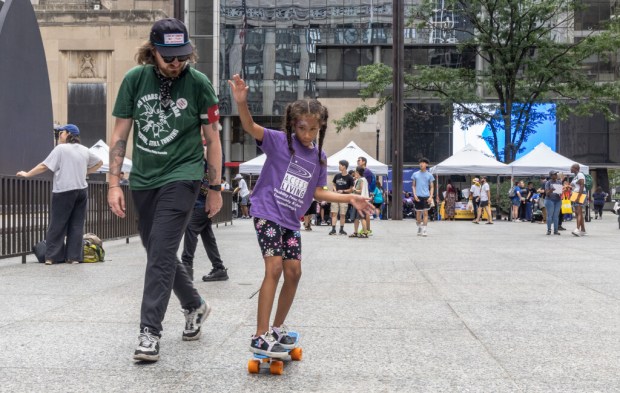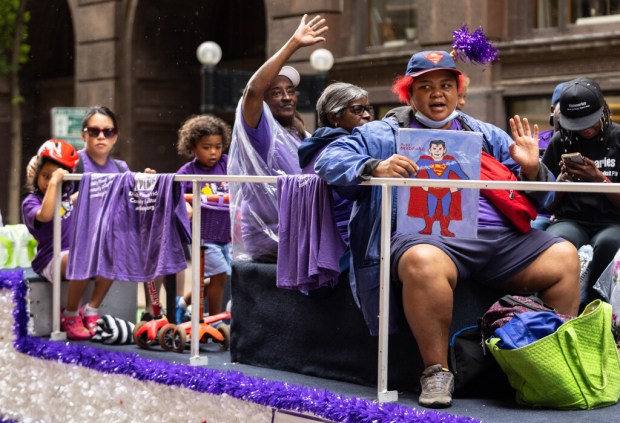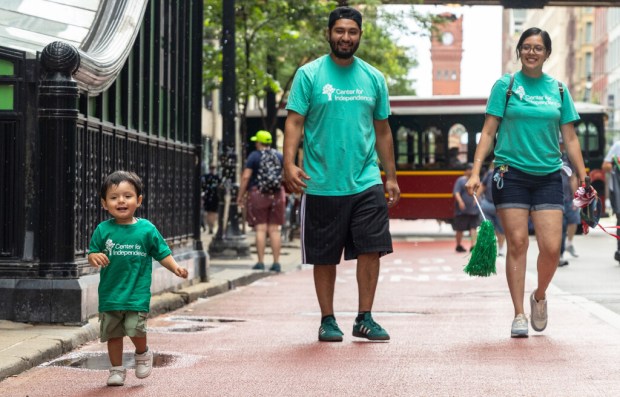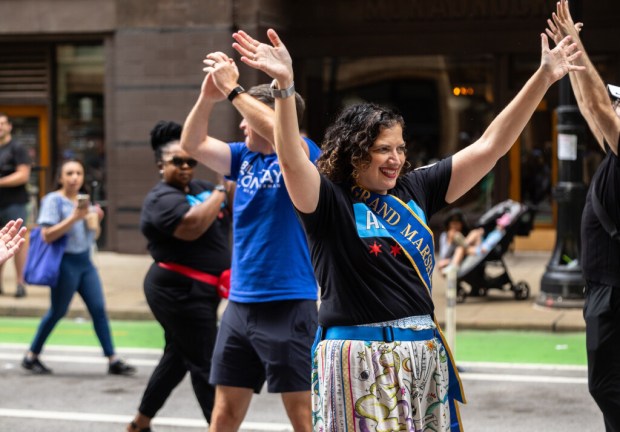You wouldn’t guess that Matt Keeth has a severe visual impairment from the way he skateboarded up and down Chicago’s Disability Pride Parade in the Loop — if not for the red-and-white striped cane he rolls in front of him.
Keeth, 31, a southern Idaho native, had always experienced a small degree of visual snow — like television static in the eyes — but three years ago, he woke up to the more extreme visual snow syndrome, a neurological condition in which visual snow is accompanied by other symptoms such as headaches, migraines and vertigo.
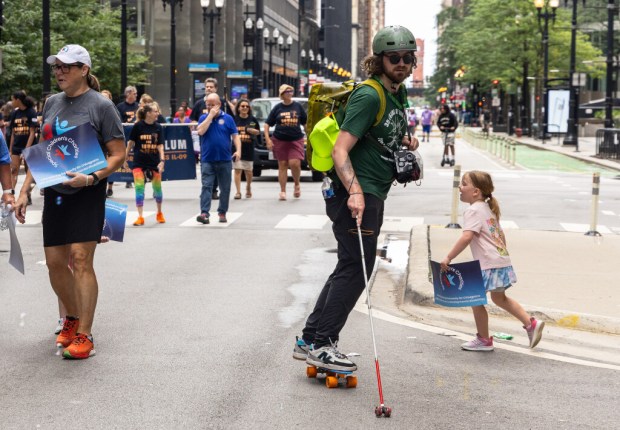 Matt Keeth, who is visually impaired, rides a skateboard with a rolling visual impairment cane during the Chicago Disability Pride Parade to celebrate National Disability Pride Day, July 26, 2025, in the Loop. Keeth is also a photographer and seeks to empower kids who have visual impairment. (Dominic Di Palermo/Chicago Tribune)
Matt Keeth, who is visually impaired, rides a skateboard with a rolling visual impairment cane during the Chicago Disability Pride Parade to celebrate National Disability Pride Day, July 26, 2025, in the Loop. Keeth is also a photographer and seeks to empower kids who have visual impairment. (Dominic Di Palermo/Chicago Tribune)
As a recent member of the disabled community, he has struggled with accepting his new limitations and finding a place where he feels welcome. “With my disorder, I don’t really fit in a box with a large amount of the disability rights groups,” he said. “The Disability Pride Parade was a way to represent my disability as well as have pride for disability groups as a whole, because there’s almost a third of the population that is disabled, or potentially will be disabled, and it’s a group that is ever-expanding.”
On foot, with walkers, canes and crutches, in wheelchairs, power chairs, leg braces and scooters, hundreds of people of all ages and abilities made their way up Dearborn Street towards Daley Plaza for the longest-running parade of its kind, with 22 parades since its establishment in 2004. This year’s theme was “35 Years of ADA: Still Rising, Still Thriving!”
At Daley Plaza, marchers were met by dozens of tents set up by disability groups explaining their services and offerings to the community, as well as live music and performances.
Show Caption
1 of 6
Thomas Hyche, 13, marches with Rush University Medical Group in the Disability Pride Parade to celebrate National Disability Pride Day Saturday, July 26, 2025 in the Loop of Chicago. Hyche’s mother is an employee of the medical group. (Dominic Di Palermo/Chicago Tribune)
As much as the parade was about celebration, it was also about protest. The first sound from the parade’s leaders was a chant of “Access now!” Towards the end of the procession, a delegation from the Party for Socialism and Liberation chanted and carried signs calling for disability justice and protections for Medicaid. Earlier this month, President Donald Trump signed a bill into law that would cut Medicaid.
“Disability Pride was never just about policy,” said Nirali Chauhan, vice president of the Disability Pride Association. “It’s always been about presence, and it’s about gathering in public to say we are not a problem to be solved. We are artists, we’re organizers, neighbors and we deserve to be held fully in society, not in spite of our challenges, but because of the depth they’ve carved into us.”
Chauhan survived a traumatic brain injury 10 years ago, when an SUV hit her as a pedestrian. “The injury changed everything,” she said. “It affected my movement, my energy and the rhythms of my daily life.”
“The Disability Pride Parade gave me a space where I really didn’t have to minimize what I was carrying or make it palatable,” she said. “I could show up exactly as I was.”
The parade was led by grand marshal Rachel Arfa, commissioner of the Mayor’s Office for People with Disabilities and the first deaf person ever appointed to a mayor’s cabinet in the United States, according to the MOPD website.
Under her leadership, the MOPD launched a career center for people with disabilities, expanded access to resources such as American Sign Language interpreters for public events and continued the Home Modification program, which recently achieved the milestone of 2,000 homes made accessible.
“Disability Pride to me means to be able to share the identity of having a disability and be coming together with our community,” said Arfa, who marched alongside a delegation from MOPD. “It means so much to me that I’m being asked to represent the disability community at the parade and the support that the disability community provides to each other.”
Numerous public and private disability-focused groups, as well as those representing cultural groups and medical services marched in the parade, with one of the most visible being El Valor, a nonprofit that serves children and adults with disabilities in Chicago, particularly within the Spanish-speaking community. Their blue-and-white float blasted celebratory music as participants danced on and around the float.
Arfa said the recent federal actions threaten disability rights in America, adding that recent moves by the Trump administration to dismantle the Department of Education will affect the Individuals with Disabilities Education Act and Section 504 of the Rehabilitation Act. Additionally, many disabled Illinoisans are on Medicare or Medicaid; cuts to these programs will drastically affect them.
Chauhan explained that the Americans with Disabilities Act has been so much more impactful than most Americans realize. “Curb cuts, elevators, closed captioning, automatic doors: All of those things exist because disabled people fought for them, and now they benefit everyone. So if you’re a parent pushing a stroller, an older adult using a walker, a person recovering from surgery, a tourist pulling a suitcase — anyone that’s ever appreciated a ramp, a grab bar, or even the option to work remotely. That’s the legacy of the ADA.”
For Keeth, the Disability Pride Parade has been a way to find strength and joy in community. When he developed visual snow syndrome, he described going through intense periods of grief. But at his first Disability Pride Parade, he spoke with a few teens associated with The Chicago Lighthouse for the Blind about photography as a career.
“It was just incredibly inspiring to see these kids (who) have potentially lived with their disability, their vision impairment, longer than me, be genuinely so excited to learn something new,” he said. “And it wasn’t necessarily through the lens of, I’m a vision-impaired person learning photography. It’s, I’m a teenager, I’m a kid. I’m learning a new skill set for the future.”
“From the beginning, I kind of saw disability as how it is traditionally seen: the inability to do certain things,” he said. “But honestly, once you get through that grief cycle, once you get to the acceptance level of it, there’s a lot of beauty in disability, because you can find middle ground with just about anyone, whether it’s someone actually within the disabled community, or just someone else that’s gone through strife, whether it’s financial, medical, personal — it humanizes everything exponentially.”
Originally Published: July 26, 2025 at 2:31 PM CDT
